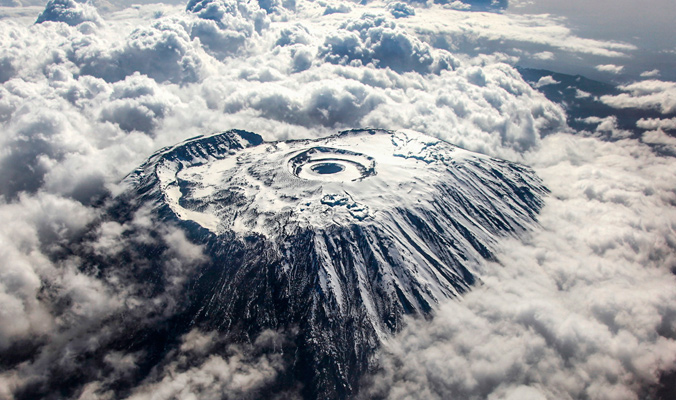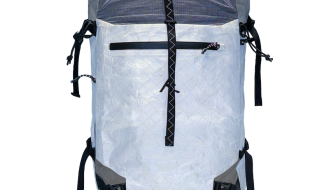
Skiing Kilimanjaro: Nothing a hundred men or more could ever do. [Photo] Kyle Mijlof
When Hannah Follender was studying abroad in Kenya in 2009, she climbed to the top of Kilimanjaro (19,340 ft.), where she saw a large basin filled with snow. Although she wasn’t there to ski, the glaciers sparked an idea—she would return someday with skis in tow. But, Follender later found out, it is illegal to tag the Seventh Summit.
“It looks perfect during the snowy season,” says Follender of the conical peak on Kibo, the highest of Kilimanjaro’s three peaks. Alternatively, the Heim Glacier, near the Umbwe Route, has receded significantly. “The whole plan was to go back and ski that [Kibo], and I spent the last couple of summers up in Jackson, Wyo. training.”
While in Jackson, Follender crossed paths with Kit DesLauriers, the first person to ski all Seven Summits, who offered cautious advice to Follender after twice attempting to get a permit to ski and twice getting rejected. Follender was similarly rejected.
In 2006, like several other notable skiers and riders, DesLauriers went ahead and descended Kilimanjaro illegally, sneaking her skis up the mountain and only telling a handful of people of her mission.
“The answer to why I went ahead with skiing without a permit was driven by the fact that it was part of a larger goal, the Seven Summits,” she says, “but also by my feeling that some rules are made to be broken in certain circumstances.”
Both Follender and DesLauriers say that the Tanzanian decision to close the summit to “pleasure devices” like skis and snowboards is grounded in safety; Kilimanjaro National Park is unaccustomed to seeing snow travel and its potential risks and therefore lacks the associated rescue protocols. And although skiers like Follender and DesLauriers are experienced in the mountains, the park worries about spreading the wrong message to the general public that the volcano is skiable.
While Kilimanjaro National Park holds steadfast to their rule, the glaciers and snowy terrain on the mountain are under a different constraint: time. A recent estimate from the American Geophysical Union suggests Kilimanjaro’s northern glaciers could be completely gone by 2030.
“That was another motivating factor to go ski,” Hannah Follender says. “Just to see what’s going on there…it’s pretty sad.”










“Some rules are made to be broken in some circumstances”?!
I can understand if there was a greater good, a life at risk, or a tremendously noble cause was that served the advancement of humankind, but when it is self -serving?! Sorry, Backcountry Mag, I just don’t support Ms DesLauriers attitude. That was just plain disrespectful of the people that work hard to keep that park operating.
With that in mind, I suppose it would be OK if I decided to climb Shiprock because…well, just because I really, really, want to (I realise there is a slight difference) ?
The article seems to avoid whether Ms Follender intends to seek a permit, give up on it, or ski it stealthily. Any further comment?
Agreed, stay away from Africa if you thik your personal goals outweighs the locals right to govern!!! REALLY? I am too a KSP 95′ ALUMNUS AND VAIL NATIVE AND I WOULD NEVER TRY THIS, SO DISRESPECTFUL…
Get bent Nicole. Vail sucks.
Vail sucks!!!!!!
Regarding skiing on Kilimanjaro, the Tanzanian authorities have several reasons for restricting this activity, while rules generally exist for good reasons, there are rare circumstances where breaking them might be justified. However, this requires careful ethical consideration and shouldn’t be done lightly.
Environmental protection: Skiing could damage the delicate alpine ecosystem.
Safety concerns: The mountain’s terrain and weather conditions pose significant risks to skiers.
Resource allocation: Park rangers may not be equipped to handle ski-related emergencies.
Precedent setting: Allowing skiing could lead to demands for other potentially disruptive activities.
As for Ms. Follender’s intentions, it would be unwise to speculate without more information. The ideal approach would be to engage in dialogue with local authorities to understand their concerns and potentially work towards a mutually agreeable solution.
Ok so after Climbing Mt. Kilimanjaro 40 times with Zara Tours and also being a decent skier, I have always thought that on a good day after a decent snowfall that you could quite possible ski uninterrupted from Uhuru Peak to just above Stella point at Rebmann Glacier.
It doesn’t really have anything to do with “respect”. It is a mountain and not a human being.
I can understand the attraction of skiing Kilimanjaro. However, local regulations are in place for a reason and should be respected. Safety and rescue protocols are not established and it is in the best interest of all parties, both visitors and local emergency personnel to take the precautions necessary to ensure everyones safety. Until protocols are established to handle situations involving skiing, climbing Mount Kilimanjaro will have to suffice.
Which reason is that??
Rescues on Kili happen daily. Usually car evacuation from lower mountain like Horombo Hut.
Unfortunately, sometimes regulations are to protect the agency, government or business – not the environment or person. That’s the case here. Ski it at your own risk… if you get hurt, expect no support, rescue or help. Also, dont, promote, advertise or glout about your acomplishment. Too bad that “responsibility for one’s self” is not acceptable in our society. Nor is a non-glorifying achievement (i.e. if it’s not on Instagram it doesn’t count). Thus, I guess we just have to make it illegal (but do it anyone and just don’t tell!).
Go and smash turn that f*cker. To ski Kilimanjaro would be a pinnacle accomplishment. To bitch about your opinion on BackCountryMagazine is a low hanging accomplishment.
Indeed, skiing is not allowed from peak of Kilimanjaro and if there was a problem, local guides could have their licenses revoked!
It’s understandable why Kilimanjaro National Park has implemented strict regulations against skiing on the mountain, as they are concerned about safety and the potential risks involved. However, it’s a shame that experienced skiers like Hannah Follender and Kit DesLauriers are not allowed to pursue their passion and explore the snowy terrain on Kilimanjaro. With the glaciers on the mountain predicted to disappear by 2030, it would have been a unique opportunity to witness and document the changing environment. The restrictions on skiing seem to be missing out on the chance to showcase the beauty and potential of Kilimanjaro as a skiing destination.
I don’t think there is enough snow to ski after carrying your skies for almost 5 days and across the content. Not worth even thinking about it!
Besides there are restrictions in place by Kilimanjaro National Park Authorities
Fascinating story! It’s a shame permits for skiing Kilimanjaro are unavailable. The environmental impact of receding glaciers is a serious concern.
Rescues on Kili happen daily. Usually car evacuation from lower mountain like Horombo Hut.
I am not sure that Skiing could have been possible in a mountain with such terrain, given the nature of the activity. However, I believe professionals are exactly the reason why this shouldn’t have to be the case.
I understand from the article that Tanzania prohibits skiing on Mount Kilimanjaro primarily due to safety concerns. Kilimanjaro National Park, which oversees the mountain, is not equipped to handle the complexities and risks associated with skiing. This includes the lack of rescue protocols that would be necessary in the event of an accident on snow-covered slopes.
Despite the skills and experience of individual skiers like Hannah Follender and Kit DesLauriers, the park authorities are likely concerned about the broader implications, including the possibility that allowing skiing might send a misleading message to the general public that Kilimanjaro is a suitable skiing location. Given that the park is accustomed to more traditional trekking activities and may not have the infrastructure or expertise to support skiing safely, the ban seems to be a preventative measure to ensure the safety of all visitors.
Hannah Follender’s experience on Mount Kilimanjaro highlights the unique allure and potential of skiing in such an iconic location. Given the interest and enthusiasm shown by experienced adventurers, it might be an opportune time for the Tanzanian government to consider permitting skiing activities in designated areas on Kilimanjaro. By establishing controlled zones where safety protocols can be rigorously implemented and monitored, the government could potentially open new avenues for tourism while ensuring the safety and preservation of the mountain’s environment.
Skiing and snowboarding are prohibited on Kilimanjaro. The National Park’s official policy states that “no pleasure devices” are permitted. This includes skis, snowboards, paragliders, and similar equipment.
Kilimanjaro’s snowcaps have fascinated adventurers for decades, but skiing there is prohibited. This is mainly to protect the fragile glacial ecosystem. However, with rapidly retreating glaciers due to climate change, the issue may soon become moot—there may not be enough snow to ski on, even if it were allowed.
Skiing on Kilimanjaro is impermissible for environmental and regulatory reasons. Climbing authorities aim to preserve the mountain’s unique environment. Yet, with the glaciers receding at alarming rates, soon the question may switch from permission to possibility: shrinking ice and snowfields may simply render skiing physically impossible.